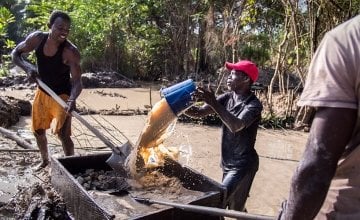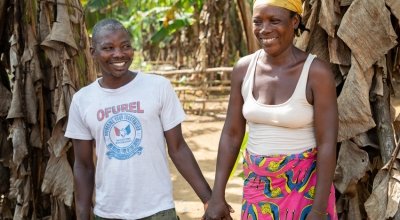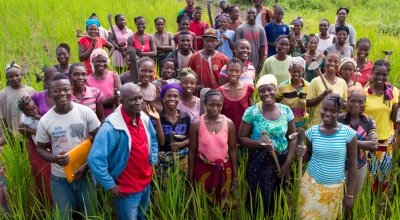
Read our 2023 annual report

Knowledge Hub
What happens to an Ebola clinic when epidemic moves on?

Kieran McConville visits a diamond town deep in the forests of Liberia to find how one Ebola treatment centre has undergone a dramatic change of purpose.
This was a small village, maybe ten houses... and then somebody found diamonds.
Sam Holder is leading us up a narrow bush path towards John Logan Town, a small city deep in the forests of Grand Bassa County in northern Liberia. It took two hours driving to get here from the main road, along a deeply rutted and often flooded dirt track. Eventually the water was too deep for even a Land Cruiser to get through and the only passage was on foot, using slippery logs to cross the swollen streams.
The city in the forest
As we crest a hill, we come to a giant clearing in the trees, and the diamonds’ effect on this community is clear. Hundreds of tin shacks spread out, randomly filling the available space. “We estimate over 20,000 people live here now,” Holder says. “They have come from all over West Africa – Guinea, Sierra Leone, Cote d’Ivoire, even from Mali. They call it ‘The city in the forest’.”

Potential for disaster
The mines themselves are primitive diggings on waterlogged plots and the work is backbreaking. Men spend hours thigh-deep in brown water, clearing, digging, sifting, and grading — all in the hope of getting rich quick.
“It’s a bit like the American west in the 1860s,” comments Sam’s colleague, Dale Hogland. Both men work for Concern, which has been in Liberia on and off since 1991.
“With this many people from such disparate backgrounds in such a remote place, you can see the potential for disaster with Ebola,” Hogland continues. “All it would take is a few cases and these people would start to scatter in all directions. It would be a nightmare to track them and to contain any outbreak.” As it happened there were quite a few confirmed cases in October and this was a spur for action.
Preparing for Ebola
The decision was taken to build a treatment facility in John Logan Town, which could safely deal with Ebola cases. Community Care Centres are the most basic form of Ebola facility, designed to plug the gaps between the bigger treatment units.
“To be honest, we were initially reluctant to get involved with this – not being a medical organization,” Hogland says, as we walk along the town’s bustling main street. “But those were extraordinary times.”
He’s referring to last months of 2014 and early 2015, when the Ebola virus was raging through Liberia, eventually killing over 2,500 people.
It was a logistical nightmare for our people to get it built, given where we are.
The Centre
But built it was. And it’s an impressive sight on the northern end of the town — a dozen or so zinc-roofed buildings containing triage, isolation, and treatment rooms, as well as latrines, a water-purifying plant, and an incinerator. The compound is surrounded by a high fence and powered by a generator.

Stephen B Tarr is the senior clinician in charge, tasked with leading a team of 15, who were brought in to staff the facility. “We came here to serve our people, when our country called on us,” he says. “Most of us came to this place from Buchanan or Monrovia.”
Nothing to do
By early March the centre was complete, supplies were in place, and the staff trained to deal with Ebola cases. Then… nothing happened.
“By some stroke of good fortune, Ebola moved on from John Logan Town,” Dale Hogland recalls. “For a month we had this strange situation where we had a fully equipped treatment unit, staffed by a team of professionals, with basic medicines in stock… and there was nothing for them to do.”
Eventually the threat of Ebola began to recede and the question arose of what would happen to the centre. “We have developed quite a close relationship with the community here and we talk with the leaders all the time,” Sam says. “Suddenly we realized what could happen in this place.”
An idea is born
Here was a town, with as many as 25,000 people living in the immediate area — and the nearest health facility up to five hours walk away. People were falling sick and dying from preventable causes. Pregnant women with complications were essentially going without care.
Hogland takes up the tale. “There was a lot of hand-wringing and debate about how we could make this work. But eventually we hammered out an arrangement with the Ministry and an American NGO called Americares, who agreed to run the facility as a basic health centre.”
The doors opened to the public on March 21st and the response was immediate.
“In the first few week we were seeing up to a hundred patients a day,” Stephen B Tarr says, “and even now there are on average fifty to sixty every day. We deliver primary healthcare, treating people for malaria, respiratory tract infections, diarrhea, and other everyday illnesses. The more serious conditions we refer to the Hospital in Buchanan.”
From death to life
The vigilance for Ebola continues. At the triage area just inside the front entrance Epheram Dumbar interviews patients and takes their temperature. He is a man who knows all about the deadly disease.
“Late last year I went to my hometown to care for my mother when she fell sick,” he says. It was Ebola and sadly she did not live. Epheram himself contracted Ebola and spent three weeks in a treatment unit, clinging to life. But he survived and is back on the front line.
A man of few words, he simply says, “I am happy to be able to help these people.”

And two buildings away, something very special has just happened. Nurse midwife, Alice M Narmah, leads us through a double door with a beaming smile.
“I have delivered thirteen healthy babies since we opened… and this is the latest one.” Sitting on a bed, 18-year-old Doris Kpah cradles a tiny baby boy, wrapped in blankets and just a few hours old.
“I was in pain last night and came here. He doesn’t yet have a name,” she says. For many women living in remote communities like this, the outcome could have been very different. Liberia has one of the highest maternal mortality rates in the world.
Journey
As we make our way back through John Logan Town, Dale Hogland glances back. “This has been quite a journey,” he muses.
We built that place to deal with Ebola and the ironic thing is, if we had actually treated any cases there, we would probably have ended up burning it to the ground. Now look what’s happening.
Keep in touch
Find out more about this, and our other work, by following us on Instagram.





